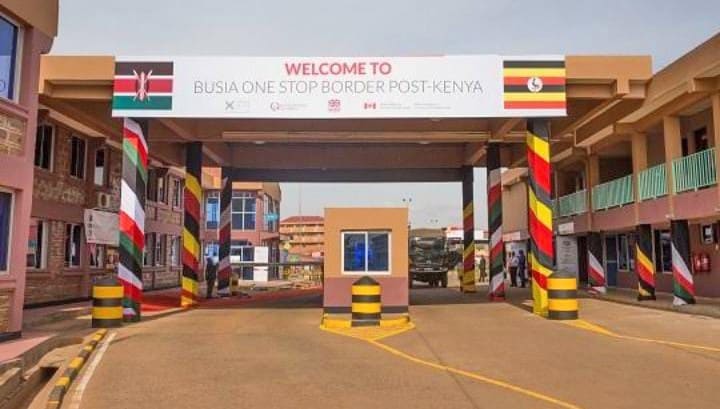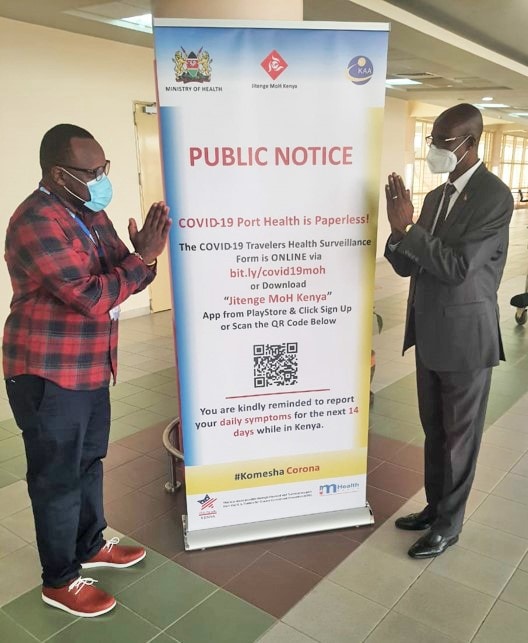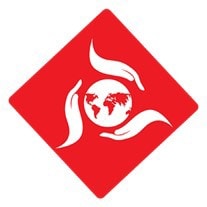Innovations in Africa Amid the Pandemic

Busia One Stop Border Post, one of two major points of entry along the Kenya and Uganda border, handled about 300,000 truck crossings annually in the pre-pandemic period and comprised 80 percent of transnational essential cargo transport through Kenya.
As COVID-19 continued to spread, the number of cases rose, and new variants emerged. The pandemic also affected people’s ability to access goods and services for everyday living worldwide. Despite the COVID-19 pandemic negatively impacting services such as supply chains, and other aspects of our daily lives like travel, some positive outcomes arose from the pandemic.
Public health officials in East Africa used innovative ideas to tackle threats from not only COVID-19 but also other infectious diseases. The pandemic highlighted the importance of information sharing and coordinating response to public health emergencies between neighboring countries. This, in turn, made it possible for both CDC headquarters and field staff from the CDC’s Division of Global Migration Health (DGMH) in the National Center for Emerging and Zoonotic Infectious Diseases to support several projects that strengthened border health coordination between Kenya and its neighboring countries, as well as Kenya’s overall public health capacity.
Bringing Countries Together to Address Public Health Threats

Charles Kamau of mHealth Kenya (left) provides a roll-up banner to Benjamin Murkomen (right), head of Port Health Services, Jomo Kenyatta International Airport.
Cross-border collaboration between neighboring nations has significant potential to minimize the spread of diseases across international borders while maintaining the safe transport of essential goods. In East Africa, officials in several countries recognized the importance of collaborating to strengthen public health measures, especially at points of entry (POE).
Before COVID-19 was on anyone’s radar, DGMH staff had plans to help coordinate multi-agency and multisectoral meetings between officials at the land border crossings between Kenya and two of its five neighboring countries—initially with Uganda and later with Tanzania. These plans included discussing strategies to increase information sharing, improve public health capacity at POE, and use simulation exercises to test ideas during real-life scenarios.
The COVID-19 pandemic escalated the urgency of the meetings. While the countries enforced measures to limit COVID-19 transmission, DGMH staff brought this plan to fruition by providing technical and financial support for a hybrid (virtual and in-person) binational meeting between Kenya and Uganda. Participants identified priority areas for collaboration, including synchronizing notification and information sharing across borders, management of COVID-19 in travelers, and entry requirements. They also developed a joint action plan to strengthen cross-border collaboration to protect the region from public health threats at POE.
Protecting Health at International Borders in East Africa
Protecting health at the borders also involves meeting the need for safe transport of essential goods between countries. Addressing this priority led health officials in Kenya to develop a mobile-phone-and-web-based application called “Jitenge” (a Swahili word for self-isolate). Jitenge is a module within the Emergency Alert and Response System (EARS) used to coordinate the response to the pandemic by Kenya’s Public Health Emergency Operations Center (PHEOC). The Jitenge application enabled transnational truck drivers and crew traveling to and from Kenya to report symptoms occurring before, during and after travel.
When the need for COVID-19 testing arose, officials used data from Jitenge to query the national database of COVID-19 test results. If a matching negative result was found, Jitenge generated a negative SARS-COV-2 certificate with a quick response (QR) code that port health officials could scan to verify the certificate’s authenticity. The success of Jitenge resulted in another system called the Regional Electronic Cargo and Driver Tracking System for use by transnational truck drivers and crew in Kenya, Uganda, Rwanda, and Burundi.
Tracking Public Health Threats on Land and in Air
DGMH staff and port health officials worked with developers to take Jitenge further and created a similar system for international air travel. In the past, Kenya’s port health authority used the paper-based Travelers Health Surveillance Form to identify potentially infected travelers during public health emergencies as part of a strategy to prevent importation of disease. Relying on paper-based forms proved difficult over time since it was resource and labor-intensive, ineffective due to incomplete data, and inefficient for tracking persons if necessary.
With the digitization of the Travelers Health Surveillance Form, international air travelers can now notify public health officials of COVID-19-like symptoms before or after arrival in Kenya. If a traveler reports symptoms, someone from the PHEOC will follow up with them. Although designed in response to the COVID-19 pandemic, Jitenge may be used to respond to other public health emergencies and can be activated and deactivated as needed.
Building Public Health Capacity Behind the Scenes

The Jitenge app, which connects to the Kenyan Emergency Alert and Response System, was used by transnational truck drivers and crew crossing the Busia One Stop Border Post.
When it comes to POE activities, every country operates differently. In Kenya, the national government controls POE activities. DGMH staff worked with Kenya national officials to support the Ministry of Health’s (MoH’s) Division of Port Health Services’ efforts and developed an online “4W matrix” to track port health activities. The 4W matrix tracks Who is supporting, Which port health activities, Where and When the activities are taking place. Using this system, port health officials based at the POE upload their needs (e.g., trainings, additional human resources, personal protective equipment in the tracker, where potential partners can log in to identify areas needing support.)
The MoH also encourages partners to use the tracker to ensure that intended support is aligned with the POE needs. This helps avoid duplication of activities and makes sure the needs of the POE are met and aligned with the national and county government priorities. This system was and continues to be especially useful during the COVID-19 response when several partners and local organizations had resources to support POE.
Responding to Travelers’ Informational Needs
DGMH staff provided technical support to the Kenya MoH’s Division of Port Health Services in preparing COVID-19 Traveler-related Frequently Asked Questions (FAQs). The questions commonly received focused mostly on COVID-19 testing, vaccination, and exit and entry requirements. These FAQs were uploaded on the MoH website for easy access by travelers and partners, the FAQs are available online under the COVID-19 protocols and guidelines tab.
The COVID-19 pandemic highlighted a critical need for public health capacity at POE. Innovations like the ones in Kenya and East Africa are major accomplishments in the fight to stop the spread of COVID-19. However, with the increased demand for travel and continued need for importing and exporting goods, public health officials worldwide continue to face challenges. Using collaborative approaches like the ones described above means that COVID-19 response efforts have the potential to impact international travel well beyond the pandemic by strengthening border health systems to control regional and global outbreaks.
DGMH looks forward to working with ministries of health in Kenya and neighboring countries to address gaps and protect public health during international trade and travel through dynamic, responsive, efficient, and sustainable port health services.